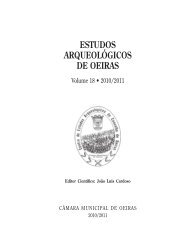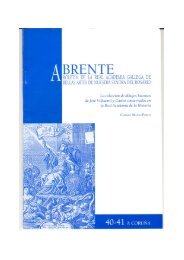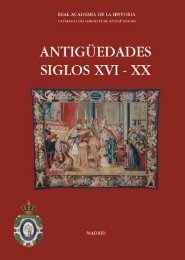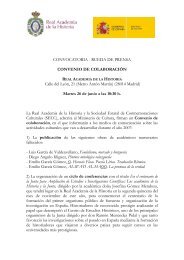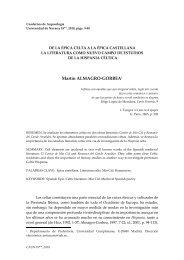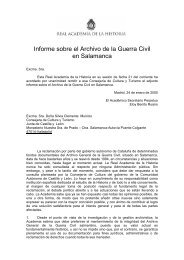GH24 CUBIERTA 2, page 1 @ Normalize - Real Academia de la ...
GH24 CUBIERTA 2, page 1 @ Normalize - Real Academia de la ...
GH24 CUBIERTA 2, page 1 @ Normalize - Real Academia de la ...
You also want an ePaper? Increase the reach of your titles
YUMPU automatically turns print PDFs into web optimized ePapers that Google loves.
La aplicación <strong>de</strong> <strong>la</strong> Fotografía a <strong>la</strong> Arqueología en España (1860-1960)<br />
Años <strong>de</strong>spués, <strong>la</strong> obra <strong>de</strong>l investigador americano Rhys Carpenter tuvo una influencia fundamental<br />
en <strong>la</strong>s valoraciones siguientes sobre el grado <strong>de</strong> influencia griega y oriental que habría existido en <strong>la</strong><br />
formación <strong>de</strong>l mundo ibérico. En su conocida obra The Greeks in Spain (1925), Carpenter se mostraba<br />
<strong>de</strong>udor <strong>de</strong> los trabajos <strong>de</strong> Schulten y Bosch. Hacia Bosch mostraba, a<strong>de</strong>más, “more personal acknowlegments<br />
to make, for friendship’s sake and for material assistance in photographs and publications”<br />
(Carpenter, 1925, VII). Esta anécdota muestra los importantes contactos que Bosch mantuvo siempre<br />
con los investigadores extranjeros pero, también, <strong>la</strong>s mutuas consultas entre investigadores que, sobre<br />
el tema fotográfico, <strong>de</strong>bieron ser cada vez más frecuentes. La investigación que el americano llevó a<br />
cabo asumía este documento gráfico como una parte fundamental: “I have also to thank Dr. Mélida of<br />
the Museo Arqueologico of Madrid for permission to photograph the three Santa Elena bronzes and<br />
to make a drawing of the fragment of Iberian moulding” (Carpenter, 1925, VII).<br />
En su recorrido por diferentes puntos <strong>de</strong> <strong>la</strong> geografía españo<strong>la</strong>, Carpenter realizó fotografías <strong>de</strong> <strong>la</strong>s<br />
que algunas, sin duda una selección, fueron incluidas en su obra. Así, por ejemplo, incluyó varias tomas <strong>de</strong>l<br />
Peñón <strong>de</strong> Ifach, <strong>de</strong>nominado por él Hemeroskopeion. Con varios fotograbados, Carpenter dibujaba una<br />
imagen <strong>de</strong> <strong>la</strong> montaña acor<strong>de</strong> con <strong>la</strong> interpretación histórica que le daba: “like a second Gibraltar, a true<br />
pil<strong>la</strong>r of Herakles, impressed the Phocaeans who drew up their ships behind its shelter; and what won<strong>de</strong>r<br />
that they gave it a picturesque name and called it the watchtower”. Para lograr esta impresión incluía fotografías<br />
actuales con señales marcadas don<strong>de</strong> veía restos antiguos <strong>de</strong>l Hemeroskopeion. Gracias a observaciones<br />
como “p<strong>la</strong>te III reproduces a photograph which I took from the top of the ‘tower’” (Carpenter, 1925,<br />
21) conocemos que, en su subida al peñón alicantino, el americano se acompañó <strong>de</strong> una cámara. Nadie<br />
mejor que él para tomar <strong>la</strong> fotografía que ilustrase y corroborase sus teorías. La fotografía permitía ver –reconocer–<br />
el paisaje antiguo a través <strong>de</strong>l mo<strong>de</strong>rno, al igual que el helenista Bérard había realizado, junto al<br />
fotógrafo F. Boissonnas en 1912, recorriendo el periplo <strong>de</strong> Ulises por el Mediterráneo.<br />
El objetivo <strong>de</strong> su obra era, como él mismo señaló, valorar <strong>la</strong> actividad focense en el oeste mediterráneo<br />
(Carpenter, 1925, 8). Su contribución al tema había sido, en su opinión: “The fitting of archaeological<br />
evi<strong>de</strong>nce with historical inference, the discovery of Ionic statuettes among the Santa Elena<br />
bronzes, of the lost site of the Greek town of Hemeroscopeion, the stylistic parallels for iberian pottery<br />
and iberian sculpture, the stylistic arguments for the original Greek authorship of the Lady of Elche<br />
and the Asklepios of Ampurias –these I may fairly c<strong>la</strong>im for my own contribution to the subject” (Carpenter,<br />
1925, 8). Su aportación había consistido, en lo fundamental, en <strong>la</strong> diferenciación, mediante paralelos<br />
y semejanzas formales, <strong>de</strong> elementos griegos entre los objetos atribuibles a <strong>la</strong> cultura ibérica. En<br />
suma, <strong>la</strong> i<strong>de</strong>ntificación, mediante <strong>la</strong> comparación visual, <strong>de</strong> reminiscencias griegas. Significativamente<br />
<strong>de</strong>c<strong>la</strong>raba: “Being by training an Hellenic archaeologist, I can do no less”. La influencia griega se extendía,<br />
incluso, a lo que era ya un icono <strong>de</strong> lo ibérico: <strong>la</strong> Dama <strong>de</strong> Elche.<br />
Destacamos aquí <strong>la</strong> aproximación <strong>de</strong> Carpenter respecto a los exvotos ibéricos. Así, c<strong>la</strong>sificó <strong>la</strong><br />
mayoría <strong>de</strong> los <strong>de</strong> Despeñaperros como “Tartesso-Iberian”. En ellos, el estilo artístico, <strong>la</strong>s vestimentas,<br />
<strong>de</strong><strong>la</strong>taban un origen nativo. Sin embargo, entre los “thousands there are, however, three which seem to<br />
me of capital importance. These I have photographed and reproduced on p<strong>la</strong>tes IV, V and VI” (Carpenter,<br />
1925, 38). Así pues, constatamos cómo Carpenter reservaba <strong>la</strong> fotografía para aquel<strong>la</strong>s piezas o<br />
conceptos que eran más importantes <strong>de</strong> cara a su argumentación. En este caso era, sin duda, distinguir<br />
<strong>la</strong> influencia griega, diferenciar sus caracteres entre <strong>la</strong> plástica ibérica. Difundiendo sus imágenes, <strong>la</strong> teoría<br />
se hal<strong>la</strong>ba respaldada por <strong>la</strong> parte gráfica. El lector sólo podría inferir lo que Carpenter argumentaba:<br />
“the connoiseur of Greek art can come, I think, to only one conclusion: that the satatuette was<br />
ma<strong>de</strong> un<strong>de</strong>r the direct influence of <strong>la</strong>te sixth century Ionic Greek art” (Carpenter, 1925, 40).<br />
Defen<strong>de</strong>r <strong>la</strong> primacía griega significaba subvalorar el factor púnico y oriental, <strong>de</strong>l que el investigador<br />
americano <strong>de</strong>c<strong>la</strong>raba “For in matters of art the Phoenicians and Carthaginians had nothing to teach<br />
the natives. They were artistically impotent” 294 . Los semitas habían “accepted the Sicilian Greeks for<br />
294 T. Reinach había <strong>de</strong>c<strong>la</strong>rado ya sobre el híbrido arte oriental, años atrás, en <strong>la</strong> Revue d ’Étu<strong>de</strong>s Grecques: “les mulets sont toujours stériles”<br />
(REINACH, 1898b, 60).<br />
295




